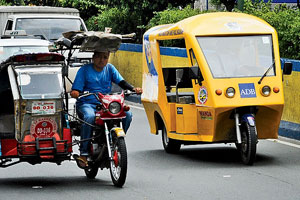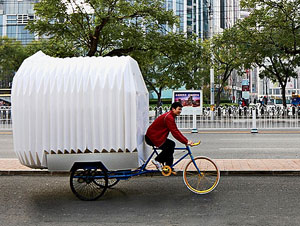sierraclub.org - sierra magazine - may/june 2013 - grapple: in the future, tricycles will solve all our problems? s
Canada's First Nations flex their sovereignty | Critter: Moon bear | Next Big Thing: Tricycles |
Graphic: Top 10 "least wanted" fossil fuel projects | On the One Hand: Acorns | Woe Is Us: Allergies go amok | Up to Speed
THE NEXT BIG THING
In the future, tricycles will solve all our problems?
 PIXIE POWER Adult tricycles—even e-tricycles—are already a thing. But are they cute enough? North Carolina start-up Organic Transit is addressing that problem with the Elf, a pedal-electric solar-powered tricycle that makes low-carbon conveyance easy and adorable. Big enough to carry an extra passenger or up to eight bags of groceries, the enclosed, egg-shaped Elf is still legal to ride on bike paths. When they cross the Misty Mountains, elfin riders can turn the throttle to get an electric boost—a lithium ion battery will take the trike 30 miles at 20 miles per hour and can be recharged from a wall outlet. Company founder Rob Cotter says the target market is people who never imagined commuting by bike. "Do you really think my aunt Kiki is going to ride uphill in the rain?"
PIXIE POWER Adult tricycles—even e-tricycles—are already a thing. But are they cute enough? North Carolina start-up Organic Transit is addressing that problem with the Elf, a pedal-electric solar-powered tricycle that makes low-carbon conveyance easy and adorable. Big enough to carry an extra passenger or up to eight bags of groceries, the enclosed, egg-shaped Elf is still legal to ride on bike paths. When they cross the Misty Mountains, elfin riders can turn the throttle to get an electric boost—a lithium ion battery will take the trike 30 miles at 20 miles per hour and can be recharged from a wall outlet. Company founder Rob Cotter says the target market is people who never imagined commuting by bike. "Do you really think my aunt Kiki is going to ride uphill in the rain?"
 LEAN, GREEN PHILIPPINES Gas-powered trikes are popular in the Philippines, where 3.5 million are in use, but their emissions aren't: They account for more than two-thirds of the nation's transportation-related air pollution. These old-school scooters may soon be on their way out, replaced by bright blue and canary yellow electric models. Backed by a $300 million loan from the Asian Development Bank, the Philippine government plans to replace 100,000 gas-powered tricycles with the e-trikes, many of which will be used as short-haul taxis. The switch will lower costs for cabdrivers, save the nation $100 million a year in fuel imports, and eliminate about 260,000 tons of carbon dioxide emissions annually.
LEAN, GREEN PHILIPPINES Gas-powered trikes are popular in the Philippines, where 3.5 million are in use, but their emissions aren't: They account for more than two-thirds of the nation's transportation-related air pollution. These old-school scooters may soon be on their way out, replaced by bright blue and canary yellow electric models. Backed by a $300 million loan from the Asian Development Bank, the Philippine government plans to replace 100,000 gas-powered tricycles with the e-trikes, many of which will be used as short-haul taxis. The switch will lower costs for cabdrivers, save the nation $100 million a year in fuel imports, and eliminate about 260,000 tons of carbon dioxide emissions annually.
 THREE WHEELS, FOUR WALLS The human-powered Tricycle House was designed by the People's Architecture and People's Industrial Design Offices, located in Beijing, for those who live in dense cities where land for housing is at a premium. Constructed from accordion-folded translucent polypropylene that lets in light from the sun or streetlights, the expandable 32-square-foot house sits on the back of a tricycle cart and can be pedaled from place to place. An ingenious interior contains a bed, sink, stove, water tank, and bathtub, along with collapsible furniture and storage spaces.—Dashka Slater
THREE WHEELS, FOUR WALLS The human-powered Tricycle House was designed by the People's Architecture and People's Industrial Design Offices, located in Beijing, for those who live in dense cities where land for housing is at a premium. Constructed from accordion-folded translucent polypropylene that lets in light from the sun or streetlights, the expandable 32-square-foot house sits on the back of a tricycle cart and can be pedaled from place to place. An ingenious interior contains a bed, sink, stove, water tank, and bathtub, along with collapsible furniture and storage spaces.—Dashka Slater
Photos from top: Courtesy of Organic Transit, Asian Development Bank, People's Architecture Office and People's Industrial Design Office
NEXT: Graphic: Top 10 "least wanted" fossil fuel projects